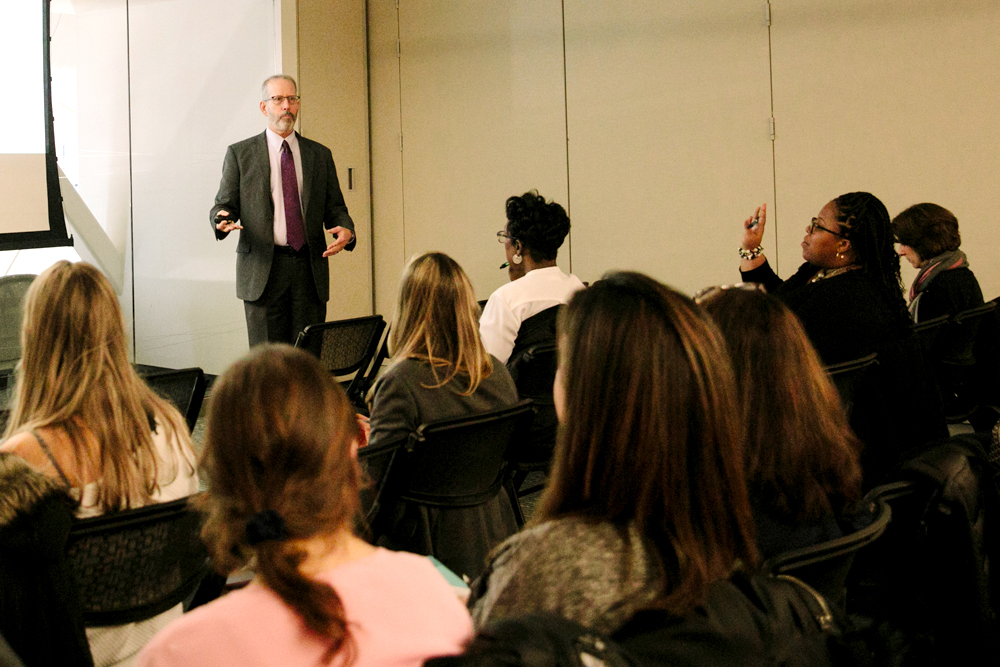After Kenn Apel, Ph.D., professor and director of the Department of Communication Sciences and Disorders at the University of South Carolina, Columbia, spoke about "Incorporating Evidence-Based Practice into Instruction," attendees came away with ideas and approaches they'll use in their own classrooms and workplaces.
After Kenn Apel, Ph.D., professor and director of the Department of Communication Sciences and Disorders at the University of South Carolina, Columbia, spoke about “Incorporating Evidence-Based Practice into Instruction,” attendees came away with ideas and approaches they’ll use in their own classrooms and workplaces.
The workshop, which took place February 25, drew 55 people to the Campbell Lounge at the Center for Recreation and Sports. It was sponsored by Adelphi’s College of Education and Health Sciences’ Department of Communication Sciences and Disorders (CSD) as part of the Ruth S. Ammon Endowment Series.
By integrating evidence-based practice (EBP)—the thoughtful, purposeful consideration of evidence that supports specific clinical practices—into clinical decision making, Dr. Apel said, speech language pathologists and audiologists show that their intent is to provide clinical practices based on data and science. His workshop’s goal was to enable participants to understand EBP’s importance within various instructional venues and to develop a set of strategies that can be used for instructing grad students as they prepare for the profession.
According to the American Speech-Language-Hearing Association (ASHA), he noted, practicing speech language pathologists and audiologists should “incorporate the principles of EBP in clinical decision making to provide high-quality clinical care.” Both the Council for Clinical Certification (CFCC) and Council on Academic Accreditation (CAA) boards require EBP as part of grad students’ program experience.
Defining That “‘Aha!’ Moment”
A follow-up Google form was emailed to attendees by Dana Battaglia, Ph.D., CSD department chair, asking for their feedback on how they might utilize the information presented by Dr. Apel and what ideas sparked an “’aha!’ moment” in them, to borrow a phrase from Dr. Apel. Respondents included five who work at Adelphi’s Hy Weinberg Center for Communications Disorders— Deborah Friedman, SLP clinical coordinator; Patrizia Giordano, M.S. ’11, SLP clinical supervisor; Felicity O’Brien, SLP clinical supervisor; Tanya Rios, M.S. ’99, SLP clinical supervisor; and Miriam Velsor, SLP clinical instructor.
Several respondents cited ideas presented by Dr. Apel that particularly resonated with them. For Rios, “My ‘aha!’ moment was definitely realizing how many of the materials used for therapy are really promoted singularly by the companies that make them and not necessarily truly evidence-based.”
O’Brien said, “I like the idea of collecting data on the innovative work that we are doing, for example, the KIDTalk/TOTalk/PreRead groups” (programs at Weinberg aimed at improving speech and language development).
For Giordano and Friedman, Dr. Apel’s ideas for collaboration between research and clinical faculty resonated. Giordano said, “I think it is an excellent idea to have the clinical staff collaborate with the faculty in regards to keeping up to date with therapeutic approaches that we can implement in the clinic.”
To Friedman, “Working as a team with mutual respect for the different skill sets the clinical and academic faculty can bring to benefit both research and the students we both serve.”
For Farrah Kramer, speech language pathologist at the New York City Department of Education (NYC DOE, her “‘aha!’ moment” of realization involved “working harder on finding evidenced-based tools. In a similar vein, Michelle Zeltser, supervisor of speech improvement at NYC DOE, said, “To look for evidence and not take everything at face value.”
Putting It into Practice
Regarding how she might use Dr. Apel’s information, O’Brien said that, “when discussing session plans with students, I am using Dr Apel’s point that selection of procedures and materials should be clinician- or goal-driven in contrast to materials-driven—[in other words,] encouraging students to think about the goal, what they are hoping to achieve and how they are going to use the materials to achieve the goal, rather than choosing an activity because the resource is available in the materials closet.”
Similarly, Giordano cited “the point he made regarding the selection of materials and how they should be goal-driven in contrast to materials-driven, meaning having the students think about the goal and what they are trying to achieve and what techniques they are going to implement in conjunction with what material they are using.”
Zeltser said she intended “to look more critically at programs and research.” Paula Okin, director of speech pathology at North Shore Speech-Language Associates, said she would “find out more about the claims made in proprietary companies’ supposed ‘research.'”
The workshop “helped make me more mindful about the source of the therapeutic techniques I am choosing,” Kramer said. Velsor said she would be more mindful of “the difference between evidence and pseudoscience.“
Rios felt “it will be easier to inform my graduate clinicians of the continued importance of finding factual evidence to back up their goals and procedures.”
Summing up, Dr. Battaglia said that all attendees left with practical knowledge and simple implementation ideas.
For further information, please contact:
Todd Wilson
Strategic Communications Director
p – 516.237.8634
e – twilson@adelphi.edu
